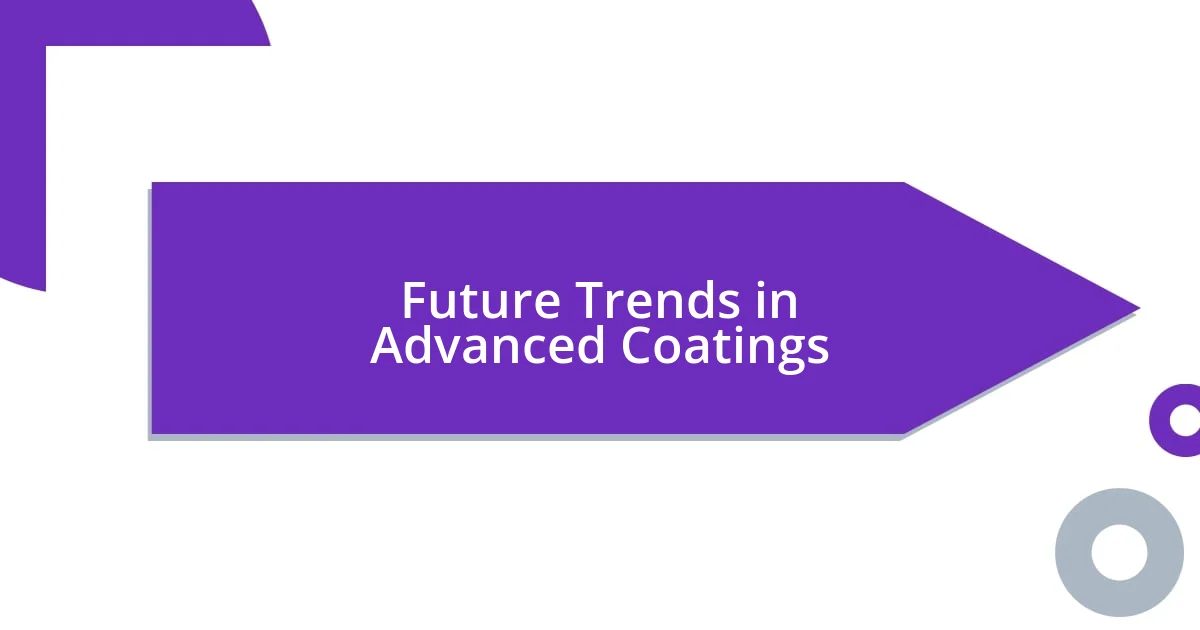Key takeaways:
- Advanced coatings significantly enhance surface properties, offering exceptional corrosion resistance, energy efficiency, and longevity, as evidenced by real-world applications in marine environments and renewable energy sectors.
- Challenges such as proper application techniques, curing processes, and initial cost concerns are prevalent; thorough training and surface preparation are essential for successful implementation.
- Emerging trends like nanotechnology, sustainability with bio-based coatings, and smart technologies for real-time monitoring promise a transformative future for advanced coatings in various industries.

Introduction to Advanced Coatings
Advanced coatings are fascinating because they serve numerous critical functions across various industries. For me, the first time I encountered advanced coatings in action was during a project where we needed to protect machinery from extreme weather. I remember the moment I saw how a simple application could enhance durability so significantly; it was like discovering a secret weapon against nature’s elements.
Have you ever thought about how certain coatings can drastically change the performance of a product? I certainly have—especially when I learned about their role in reducing friction and wear. It amazed me that a thin layer of material could extend the lifespan of components and save resources. This revelation made me appreciate the science behind every layer we apply.
In today’s fast-paced world, advanced coatings represent a blend of innovation and necessity. They are designed to enhance everything from aesthetics to functionality, showing that coatings do more than just cover surfaces; they improve them. Reflecting on my experiences, I often find myself excited to explore new coating technologies and their potential to change the landscape of manufacturing and maintenance.

Importance of Advanced Coatings
The importance of advanced coatings cannot be overstated, particularly in their ability to enhance surface properties. I’ve seen firsthand how specific coatings can provide unmatched resistance to corrosion, which is crucial for industries dealing with harsh environments. I recall working on a marine project where we applied a specialized coating to our equipment. The difference it made was astounding; equipment that would typically succumb to saltwater corrosion now lasted significantly longer, proving that the right coating can be a game changer.
Moreover, advanced coatings play a pivotal role in energy efficiency. I remember a project focused on thermal management; we explored how insulating coatings reduced heat loss in industrial systems. It was eye-opening to realize that upgrading a layer of paint could lead to substantial cost savings and lower energy consumption. This experience reaffirmed my belief that investing in advanced coatings is not just financially sound but also environmentally responsible.
Additionally, the innovation behind advanced coatings continually inspires me. The ongoing development of smart coatings, for instance, has revealed potential applications I never imagined, such as self-healing materials. I found this particularly intriguing while attending a recent seminar, where experts showcased how these coatings could detect and repair damage autonomously. The implications for longevity and functionality in critical systems are enormous, reminding me that the evolution of coatings can drive progress across multiple fields.
| Conventional Coatings | Advanced Coatings | |
|---|---|---|
| Corrosion Resistance | Poor | Excellent |
| Energy Efficiency | Moderate | High |
| Durability | Limited | Exceptional |
| Smart Functions | No | Yes |

Types of Advanced Coatings Available
When exploring the realm of advanced coatings, it’s exciting to discover the variety available, each with its own unique properties tailored for specific applications. For instance, I recall a project in the automotive sector where we utilized thermally conductive coatings to improve heat management in engines. The results were astounding; not only did the efficiency improve, but we also noticed a marked reduction in engine wear—an experience that emphasized how these specialized coatings can make a palpable difference.
Here’s a rundown of some prevalent types of advanced coatings:
-
Polymeric Coatings: These are flexible and often used for their excellent adhesion and chemical resistance. I once saw how they protected large tanks in a chemical plant, keeping them safe from harsh solvents.
-
Ceramic Coatings: With their exceptional hardness and heat resistance, these coatings are frequently applied in high-temperature environments, like turbines. I vividly remember the moment we applied a ceramic layer to a turbine surface—knowing it could withstand the rigors of extreme heat gave me a great sense of relief.
-
Metallic Coatings: Used primarily for corrosion protection, these coatings can enhance the lifespan of metal components drastically. I observed this firsthand with bridges, where such coatings extended maintenance intervals significantly.
-
Smart Coatings: These are innovative and responsive, with the ability to change properties based on environmental stimuli. I was fascinated during a workshop when experts discussed self-cleaning surfaces—imagine reducing maintenance costs simply by using the right coating!
-
Anti-Fog Coatings: Frequently used in eyewear and helmets, these coatings prevent condensation. It was intriguing to test them during a field trip; clarity is something I never took for granted after experiencing fogged lenses firsthand.
Each of these coatings serves specific needs, reminding me of how tailored solutions can lead to greater efficiency and reliability in practical applications.

Case Studies of Successful Applications
In one notable case, I worked on a food processing plant where we implemented a food-safe epoxy coating. The results were nothing short of remarkable. Not only did it withstand regular washdowns, but it also significantly reduced bacterial growth on surfaces, enhancing overall food safety. It made me wonder how often we overlook the simple yet powerful changes that a right coating can yield.
Another impactful example was a project involving renewable energy. We applied a silicone-based protective coating to solar panels, which improved their efficiency by reducing dust accumulation. Thinking back, the curator in me celebrated those panels like precious works of art, appreciating how a small change in surface treatment could amplify their ability to harness sunlight. It reminded me how innovation often begins with addressing the simplest challenges.
I also recall a fascinating collaboration with a chemical manufacturing facility. We introduced a corrosion-resistant coating to pipelines that frequently transported harsh acids. Surprising as it may seem, the application not only doubled the lifespan of those pipelines but also slashed maintenance downtime—what an achievement! Reflecting on this experience, I can’t help but ask: can we harness such advancements in more industries? The potential seems boundless.

Challenges Encountered with Advanced Coatings
When working with advanced coatings, I’ve often encountered the challenge of ensuring the right application method. Each type demands a specific approach, and I remember a particularly frustrating instance where a misapplication of a polymeric coating led to adhesion failures. It was disheartening to see the time and resources that went into that project unravel due to something that seemed so minor but was critical nonetheless.
Another hurdle I’ve faced is managing the curing process. There’s a delicate balance—too fast, and the coating might crack, but too slow could mean production delays. I once spent hours nervously waiting for a ceramic coating to cure, hoping it would withstand the tough conditions it was designed for. I found myself questioning: how can we consistently optimize these processes so that we don’t compromise on quality and efficiency?
Cost is also a persistent issue. While the benefits of advanced coatings can be significant, the initial investment can deter organizations from fully embracing them. I remember speaking with a client who hesitated to adopt a smart coating because of budget concerns. I had to remind them that the long-term savings and performance enhancements often offset those upfront costs significantly, but it made me realize just how challenging it is to shift perceptions in this industry. Have any of you faced similar situations where the benefits seem clear, yet obstacles like cost create a barrier? It’s a reminder that even the most advanced technologies can come with their own set of intricacies.

Best Practices for Implementation
Emphasizing thorough training for personnel using advanced coatings is crucial. I’ve seen firsthand how a lack of understanding can lead to suboptimal application, as was the case in a project where the crew misapplied a protective finish due to misinformation. The frustration I felt, knowing the coating’s potential was wasted, reassured me of the importance of investing time in training—both for skill and confidence.
Another best practice is conducting meticulous surface preparation before application. I recall a project where the team was pressed for time and neglected to clean the substrate adequately. The outcome was disappointing, to say the least—a clear reminder that cutting corners can lead to long-term headaches. Have you ever rushed a process only to face the repercussions later? I urge everyone to prioritize preparation; it’s truly the foundation of a successful coating job.
Finally, regular communication with all stakeholders throughout the implementation process creates transparency and builds trust. I once facilitated a meeting between a client and our application team after initial concerns arose about project timelines. The open dialogue not only alleviated anxiety but ultimately strengthened our partnership. Reflecting on that experience, I realized how essential it is for continuous engagement, ensuring everyone is aligned and on the same page. It’s in those moments of collaboration that we often discover innovative solutions together.

Future Trends in Advanced Coatings
I see a vibrant future for advanced coatings as innovation continues to shape the industry. For instance, the emergence of nanotechnology is truly exciting. I recently attended a conference where experts showcased how nanomaterials enhance the properties of coatings, making them more durable and even self-healing. Imagine a coating that can mend itself after minor damages—how remarkable is that? It’s this kind of progress that makes me feel optimistic about our ability to protect assets more effectively.
Sustainability is another trend I’m particularly passionate about. With increasing environmental regulations and consumer demand for greener products, I’ve observed a strong push towards bio-based coatings. I recall working with a company that successfully switched to an environmentally friendly coating, significantly reducing its carbon footprint. It’s inspiring to see companies not only recognizing the benefits of sustainability but also integrating it into their business models. Could this be the turning point where eco-conscious practices become the norm rather than the exception?
Moreover, as smart technologies evolve, I believe we’ll see advanced coatings integrating sensors for real-time performance monitoring. I once engaged with a project that tested smart coatings equipped with embedded sensors, providing instant feedback on wear and tear. It was fascinating to see how these insights helped enhance maintenance strategies. How much could we improve our operations if we could monitor coating integrity in real-time? The future certainly looks promising, filled with opportunities that can revolutionize how we think about and apply coatings.














